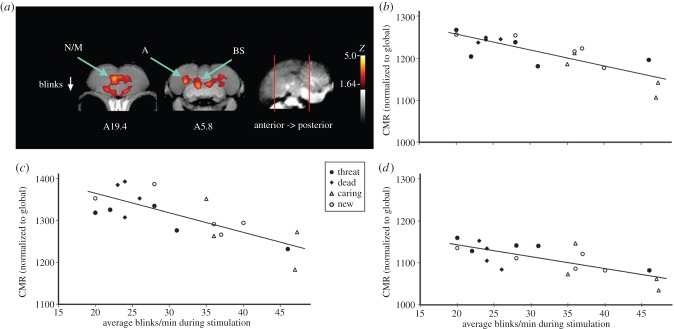Figure 2.
A fixed stare (reduced blinking), one behavioural response to dangerous situations observed in nature and in the laboratory, was associated with activation of three brain regions. (a) Voxel-wise correlations converted to Z-score maps are superimposed to a composite (n = 4 birds) structural MRI of the crow brain. Voxels with Z > 1.64 are coloured; those with Z > 3.8 (3.6 for small structures hypothesized a priori to be activated by stimulus) are considered significant with associated structures as indicated (BS: dorsal brainstem area possibly, including nucleus isthmo-opticus and locus coeruleus, Z = 4.3; N/M: nidopallium/mesopallium, Z = 3.8; A: arcopallium, Z = 3.7). (b–d) Individual values for normalized (global) uptake in each structure that met the threshold for statistical significance on Z-score voxel-wise mapping. The scatterplots we present describe the individual covariation between neural activity and blinking by all individual crows. Symbol type further describes covariation within and between treatments. Correlation coefficients describe the magnitude of covariation (effect size) between neural activity and behaviour at the brain location where the effect was greatest. (b) Differential activation of the brainstem (BS, r = −0.82) related to subject rate of blinking in each experiment (type is indicated by symbol) where blinking could be observed. (c) Differential activation of the nidopallium/mesopallium (N/M, r = −0.76) in relation to blinking by individual crows. (d) Differential activation of the arcopallium (A, r = −0.74) in relation to blinking by individual crows.

